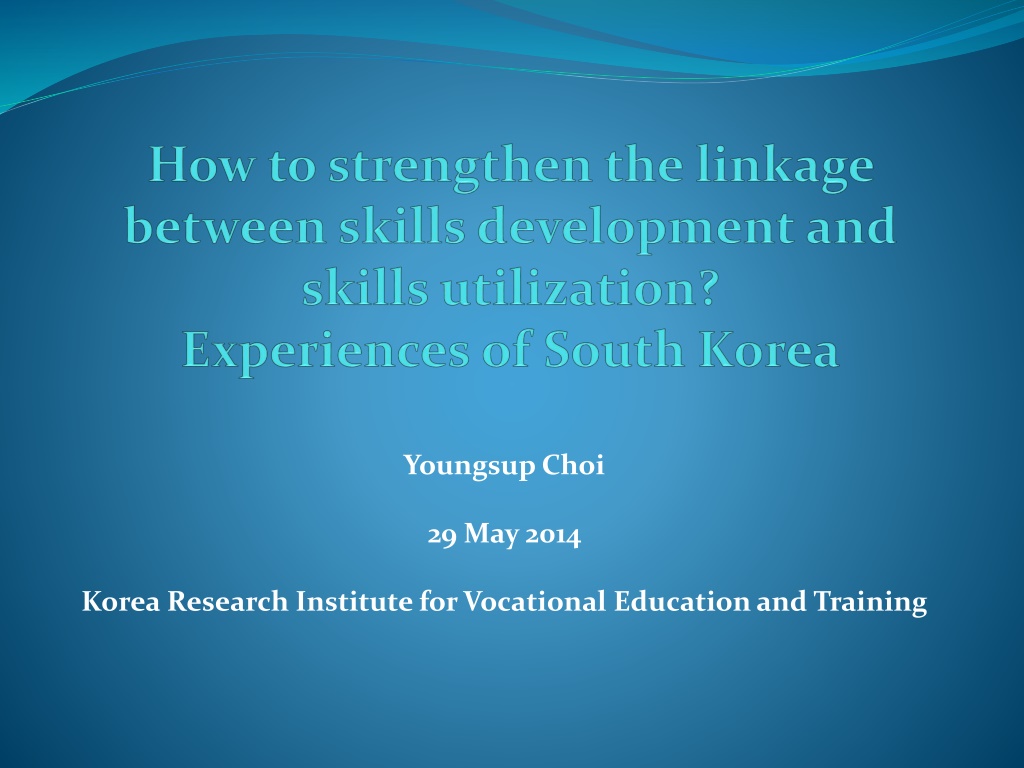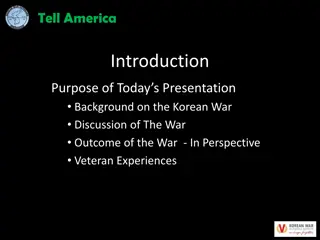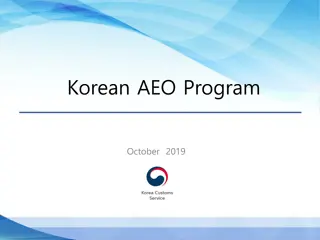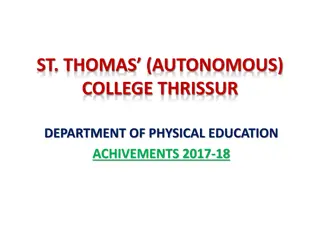Challenges and Achievements in the Korean Skills System
Despite impressive academic performance and low youth unemployment rates in Korea, a significant mismatch exists between skills development and skills utilization, leading to challenges such as a high number of NEET individuals and job vacancies in SMEs. The skills system's history reveals a virtuous cycle before the IMF era, highlighting the need for measures to realign education and training with employment needs.
Download Presentation

Please find below an Image/Link to download the presentation.
The content on the website is provided AS IS for your information and personal use only. It may not be sold, licensed, or shared on other websites without obtaining consent from the author. Download presentation by click this link. If you encounter any issues during the download, it is possible that the publisher has removed the file from their server.
E N D
Presentation Transcript
Youngsup Choi 29 May 2014 Korea Research Institute for Vocational Education and Training
Contents Quick look at Korea s youth labor market I. II. Achievements and challenges of Korean skills system III. How to restore virtuous cycle of skills system? IV. Cases of skills training for strengthening SME competitiveness Final words V.
Quick look at I. Korea s youth labor market
Superficially, well functioning Impressive academic performance of Korean students OECD PISA test score (2012): Math 5th, Reading 5th, Science 7th Ranked 3rd, 3rd, and 5threspectively when excluding Shanghai, Hong Kong and Macao,. Progression rate of tertiary education for upper secondary graduates: 70.7% in 2013 (MOE Korea) Mild youth unemployment rate (2013): Male 9.6%, Female 8.4% (15-24 years old)
Yet serious mismatch exists Substantive number of NEET Among 15-34 years old, 944,000 (7.0%) of NEET (2011) Male 584,000 (8.7%), Female 360,000 (5.3%) Chronic difficulty of SMEs in filling up the job vacancy The share of unfilled vacancy (2013): 15.6% in micro companies (5-9 employees), 5.7% in large companies (more than 300 employees) Indicating a mismatch between skills development (education and training) and skills utilization (employment) Why such situation happened? What measures required?
II. Achievements and challenges of Korean skills system
Skills system in the pre-"IMF era" Economic growth has been achieved through the ample supply of well- trained workforce as the education enrolment has continuously increased. 120 100 Net enrolment rate. Primary. Total 80 60 Gross enrolment ratio. Secondary. All programmes. Total Gross enrolment ratio. Tertiary (ISCED 5 and 6). Total 40 20 0 1971 1973 1975 1977 1979 1981 1983 1985 1987 1989 1991 1993 1995 1997 1999 2001 2003 2005 2007 2009 Absorbed by export-market oriented manufacturing sector which combined imported advanced technology with the diligence of well educated workforce IMF-era: Called by Koreans, a period in the late 1990s, when IMF imposed strict austerity program to address the currency crisis with East Asian countries
Virtuous cycle in the pre-"IMF era" Virtuous cycle between skills development and skills utilization Expansion of education increased supply of skilled workers strengthened competitiveness continued growth/increased demand for more skilled workers Almost no concern about unemployment since the beginning of economic development in the late 1960s Business strategy emphasizing the increase of market share even at low profit level: Size does matter! However, economic growth rate has started decreasing as the economic development stage getting matured since the early 1990s Sudden struck of financial crisis in East Asian countries including Korea in the late 1990s: Bankruptcy of major companies and mass unemployment
Profit-First after the "IMF era" Realizing the fragility of market-share-first strategy, large companies started putting more emphasis on profitability Segregation of core and periphery , extreme pursuit of numerical flexibility(temporary workers, outsourcing) in peripheral tasks , enforcement of the reduction of price of the products of subcontract companies sold to large companies (profit squeezing of SMEs), etc. Without social institutions to control excessively individualistic and short-sighted profit maximization strategy of large companies, severe polarization started to be appeared between large and SMEs, and between core and peripheral workers.
Polarization between large and small < Changes in production index of Large company and SMEs > 180 164.9 159.9 160 148.0 Large company 140 128.1 125.8 125.8 123.5 122.8 118.1 120 109.1 107.2 100.0 Small and medium company 112.7 113.1 107.7 100 100.0 80 2005 2006 2007 2008 2009 2010 2011 2012 <The ratio of operating profit to the net sales (%) > 2008 2009 2010 2011 5.8% 5.4% 6.5% 5.3% Large company SMEs 4.1% 3.3% 3.3% 3.1% Source : Korea Chamber of Commerce and Industry
Wage differential increased Difference of wage level between large companies and SMEs has been continuously increasing < Relative wage level of large companies compared to SMEs > (Unit: Wage level of SMEs =1) 3.5 Whole industry Manufacturing 3 2.5 2 1.5 1 2008 2009 2010 2011 2012 2013 2014 Source : National Statistical Office
Bigger wage differential in Korea Wage differential in Korea is greater than in other countries, e.g., Japan and the U.S. < Relative wage level by the size of company in Korea, Japan and the United States (%) 120.0 100 100 100 100.0 80.4 76.0 80.0 Korea(2009) 72.9 68.6 63.0 59.7 60.0 50.5 Japan(2007) 48.9 41.3 40.0 The United States(2007) 20.0 0.0 10~19 20~99 100~499 500+ (person) Source : Cho, 2012.
Mismatch in the labor market: Difficulty for SMES in recruiting talent SMEs have difficulty in securing required workers as exemplified by the higher vacancy rates and shorter average tenure in SMEs < Vacancy rate of technicians and engineers (%)> 10-29 30-99 employees 4.6 4.0 1.7 100-299 employees 3.8 4.0 4.4 300-499 employees 1.9 1.7 1.6 Over500 employees 1.0 0.7 0.7 employees 6.9 10.0 7.6 Total Master s degree Doctor s degree < Average tenure of workers (years)> 1-4 4-9 10-29 persons 30-99 persons 100-299 persons Over300 persons persons persons Science and engineering personnel 4.18 3.78 5.58 8.24 7.05 8.77 1.99 2.77 4.21 5.65 7.07 10.64 Other occupations Source : Korea Institute for Industrial Economics and Trade (2011)
Mismatch in the labor market: Underutilization of youths While general education has greatly expanded, the share of NEETs with a tertiary education is about double the OECD average (24% vs. 13%) The share among all youth is slightly higher than average Implying the excess supply of general/tertiary education to the demand from industry < Share of youth NEET in OECD countries (2011, %, 15-29 year-olds)> Source : OECD, Education at a Glance 2013
Vicious cycle in the labor market appeared A vicious circle between the difficulty of securing talented workers, worsening competitiveness and reluctance of youths with university degrees to take jobs of SMEs Difficulty of recruitment and high labor turnover in SMEs Job seeker s avoidance of SMEs Increase of NEETs Little investment to training, Longer working hours Widening wage gap between large and SMEs Adherence to the cost-competition Reduced competitiveness of SMEs
III. How to restore the virtuous cycle of skills system?
How to restore virtuous cycle? Changes in skills development to improve the relevance of VET Rehabilitation of secondary vocational education Reform of tertiary vocational education Improved relevance of vocational training through strengthened role of industry Changes in skills utilization to alleviate the labor market polarization Balanced development and co-prosperity of large and SMEs: National Commission of Company Partnership (2010) Improvement of working conditions of SMEs: Special subsidy to SME workers, subsidy for workplace improvement, etc. Regulation on the excessive use of numerical flexibility such as irregular workers, sub-contractors, etc.
Rehabilitation of secondary VE A priority issue of the Ministry of Education during the former administration (2008~2013) Increased investment: USD 15 mil. (2010), 53 mil. (2011), 60 mil. (2012, 2013) Main directions: Introduction of highly specialized VE schools: Meister high schools Strengthened cooperation with local industry Introduction of competency-based curriculum Extended use of qualified industry instructors Improvement of workplace training Once completed, 691 vocational high-schools as of 2010 will be restructured into more skills-driven schools, 50 Meister high schools, 350 specialised vocational high-schools, and remaining schools to general or comprehensive high-schools by 2015 As of 2014, 42 Meister high schools with 90% employment rate (MoE, 2013).
Reform of Tertiary vocational education Measures for Fostering Junior Colleges 2013 aims to raise employment rates of junior college graduates to 80% by 2017 from 60% in 2013 (i) fostering specialised junior colleges (100 out of 139 junior colleges by 2017 according to the needs from local industry), (ii) fostering skilled craftsman through establishing graduate schools of industrial technology master course, (iii) converting 16 junior colleges into National Competency Standards (NCS)- based Lifelong Vocational Education Advancement Colleges by 2015, (iv) assisting employment and learning experience in companies abroad for college students.
Establishment of competency-based skills development system Development of National Competency Standards (NCS): a key administration priority by investing USD 200 million until 2017. Integration of previous fragmented efforts and significant scaling up of the government investment Since 2002, MoL attempted to devise National Occupational Standard (NOS), and MoE then attempted to construct Korea Skills Standard (KSS). Strong emphasis on inter-ministerial collaboration not only between MOE and MOL, but also all the concerned ministries The development of NCS itself and learning packages based on NCS are scheduled to be completed by the end of 2014 The establishment of a new National Qualification Framework (NQF) based on the NCS will be completed by 2017.
Introduction of Korean-type work-study program Announced in September 2013, as a work-based learning model for youths benchmarking Germany s apprenticeship program By providing alternative professional career pathway, expected to alleviate the overemphasis on academic degrees 50% of practical learning through structured OJT and 50% of theoretical learning Once completed, program participants will get technical qualification or degree awarded by industry through the recognition of work-based learning If successful, new dual program will reach 10,000 companies to create 70,000 apprentice jobs by 2017, by providing; Firms with assistance for developing tailored programmes and training subsidies Apprentices with scholarships and other incentives
The role of industry strengthened Traditionally, individualized cooperation has been pursued in a way that individual company and individual school cooperate for VET program design and implementation To overcome the instability of individual cooperation, more emphasis are being put on the collective cooperation between industry and schools Regional dimension: 14 Regional HR committees established with representatives from industry, local governments and VET sector Started in 2013, still at an embryonic stage Expected to play a key role in identifying regional skills needs and ultimately, in allocating financial resources to VET programs in each region Sectoral dimension: Joint plan of MoE, MoL and MoTIE on sectoral bodies for sector-specific demands is under development
IV. Cases of skills training for strengthening SME competitiveness
Special programs for skills training in SMEs: SME HRD (training) consortium Without improving the competitiveness of SMEs, no possibility of addressing current labor market mismatch Implementation of special programs for skills training for SME workers Background of SME HRD consortium Difficulty of SMEs on identifying training needs and developing suitable training plans Limited effectiveness of employer-led training of SMEs Limited information on employers needs hinders training providers from preparing industry-oriented training programs Introduced in 2001 to train and supply a talented workforce (initial training) for SMEs suffering from shortages of production workers, and to promote the skills development of incumbent workers (upgrade training).
Features of HRD consortium Explicit contract between training providers and partner companies: To establish sustained cooperation between training providers and SMEs on the provision of employer-led training Training providers: In-house training center of large companies, public/private providers, colleges and universities Design and delivery of IVT for potential employees and CVT for current workforces using information acquired through close dialogue between providers and consortium participating companies <Key figures of HRD consortium> 2004 2005 2006 2007 2008 2009 2010 2011 2012 No. of consortium 30 47 57 70 83 96 102 134 158 No. of trainees 38,333 70,991 143,287 295,337 281,058 230,573 230,982 251,895 271,673 No. of partner companies 14,861 33,181 63,026 134,533 121,874 110,907 105,778 120,950 114,771
Example A: SW consortium Organized by a leading SW company (Company A) to mitigate the skills shortage of business partner companies In 2007, Company A was selected as a HRD consortium provider, using its well- equipped in-house training facilities and trainers In 2009, Best provider of HRD consortium In 2011, Presidential awards on Excellence of training provision to partner companies As of 2013, 87 partner companies and 37 companies participating in consortium training Initial training for potential employees to partner companies and continuous training for current workers of partner companies
Example A: SW consortium Training for potential employees Trainees not officially hired, supposed to be hired once successfully completed the training course <Needs analysis results for initial training> Difficulty of recruitment Training area: JAVA programming based on the needs analysis for partner companies Mostly required skills area by partner companies Limited supply of competent applicants due to the difference between what has been taught in schools and what has been required by companies Cobol Cobol J2EE J2EE C C Web Page Web Page C# C# V/B V/B P/B P/B Duration of training: around 4 months No. of trainees: 71 in 2011, 151 in 2012, 72 by Oct. 2013. Employment rate after training: 91.7% (2013) Necessity of skills
Example A: SW consortium Training for current employees Training area: Enhancement of comprehensive skill set for IT specialists comprising IT skills, project management skills and business skills Based on learning roadmap towards IT specialists, prepared by differentiated training courses for entry/advanced/specialist level No. of trainees: 518 in 2011, 737 in 2012, 598 by Oct. 2013. <Learning roadmap for current workers> Knowledge Knowledge Experience Experience Entry level Entry level Specialist Specialist
Example B: Partner company of Steel HRD consortium From the viewpoint of a partner company (Company B) of steel training consortium Partner company of steel training consortium organized by a large steel-making company Steel training consortium: Started in 2004, 425 partner companies, around 10,000 trainees of continuous training per year Established in 2004 with 165 employees Maintenance of steel production facilities of major steel company Suffering from the shortage of young applicants due to the unfavorable work environments such as heat, noise and dust Expected retirements of experienced skilled workers Risks of losing key competences and failure of meeting the client company s demand Decided to participate in steel training consortium in 2010
Special programs for skills training in SMEs: Subsidy for Learning organization To encourage the workplace learning of SMEs in a less formalized setting, mainly through mutual knowledge exchange of workers for actual problem shooting Based on the recognition that: contextualized learning is more effective than classroom training detached from actual workplace, the cultivation of learning culture within organization is urgently required for sustained learning participation of SMEs Started in 2006, Maximum USD 35K per company per year (max 3 year) Core-funds for organization of learning teams at the workplace, implementation of structured OJT and the use of external expertise on specific technical matters. <Number of participating companies and the amount of subsidy> 2007 2008 2009 2010 2011 2012 No. employers 243 263 307 317 334 355 Amount of subsidy 9543 7860 8625 8174 8180 8180
Example C: Auto parts company Manufacturer of automobile parts to Hyundai, Kia, GM Holden, etc. Turnover: USD 1.1 Bl (2012) No. employees : 370 (Dec. 2012) Continued requests from clients on improved quality and competitive pricing Necessity for systemic pursuit of company-wide learning strategy Using government subsidy as a leverage for organizing learning teams in the workplace Increased own investment on training and high level of employee s job satisfaction <Changes of training investment> 2010 2011 2012 Training investment (thousand USD) 81.7 107.5 130.2 No. trainees 302 295 636 Per trainee investment (USD) 334 405 559
V. Final words
Improved linkage between skills development and skills utilization: Key to stronger competitiveness <GDP per hours worked (2012)> Along with several problems in the labor market, still labor productivity is lagging behind most OECD countries. Constraining further development Norway Ireland Belgium France Germany Switzerland Austria Such situation can only be overcome by effectively utilizing precious human resources who have knowledge and skills globally competitive. Euro area Finland Canada Italy Japan New Zealand Greece Czech Republic More job + Work smart + Better education and training Korea Poland Chile Mexico 0 20 40 60 80 100 Source: OECD StatExtracts
How to maximize the contribution of VET to competitiveness? How to identify skills needs? Reliable quantitiative and qualitative information about current and future skills gap and skills shortage Not a simple matter of statistics, but a matter of establishing a system for continuous exchange of information among concerned stakeholders How to provide relevant VET programs? Close the gap between VET institutions and enterprises, individually or collectively (e.g. Sector Skills Councils) Active public investment and suitable performance monitoring system How to motivate the participation to VET? Information, guidance and counseling for students, workers and (SME) employers Financial measures such as tax credits, grants, voucher, and training levy
THANK YOU VERY MUCH! Q & A choiys@krivet.re.kr

















































